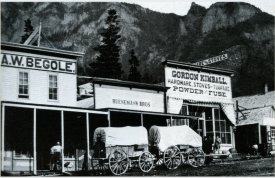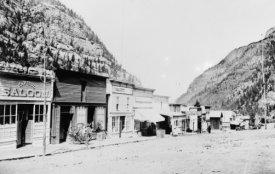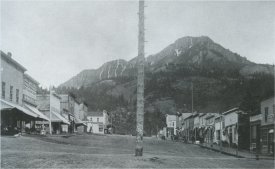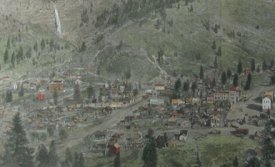|
Ouray is one of those mining towns of long
ago that refused to become a ghost town. Silver, gold and other precious ores
gave her life.
Prior to the arrival of the miners the
Tabequache Indians, a nomadic Ute tribe, traveled to this area during
the summer months to hunt for abundant game and to soak in what they referred to
as the “sacred mineral waters.” Originally named Uncompahgre City, after the Ute
word that means “hot water springs,” the name was later changed in honor of the
Ute Chief, Ouray, who was instrumental in negotiating the Brunot Agreement of
1873 between the
encroaching settlers and the Ute tribes. That treaty ultimately led to thousands
of prospectors and settlers migrating to this area of the San Juan Mountains.
The first white settlers in Ouray were
prospectors, A. W. "Gus" Begole and Jack Echols, who arrived in July, 1875 from the
vicinity of Engineer Mountain. They made a big
strike of high grade ore and named their claim the Mineral Farm.
They were followed directly by a group of prospectors: John Munroe, R. F. Long, A. J. Staley, Logan
Whitlock, M. W. Cline and others. A number of claims were laid out, including
the Trout and Fisherman lodes which were located in present day Box Canyon Park.
On August 28, 1875 the town site of
"Uncompahgre City" was laid out by Begole, Eckles, M. W. Cline, R. F. Long, A.
J. Staley and Logan Whitlock and surveyed by D. W. Brunton, who was an engineer
who happened to be in the area. Cline and Long took up residence on the
town site almost immediately, even driving stakes into the densely wooded forest
to indicate alleys and street. A few weeks afterward
several cabins
were constructed thereon. During the winter months little building occurred,
owing to the fact that the prospectors left. Over the winter of 1875-1876,
several men and a few women remained in the new settlement. Judge Long,
Captain Cline and the Cutler brothers had gone back to Saguache to obtain
supplies for those who were staying the winter. The travelers arrived in
Saguache on November 7, 1875 and left the same day with two wagons full of
supplies, arriving in Uncompahgre City on December 7, 1875. Captain cline
returned to Saguache with the two wagons full of ore from the Trout and
Fisherman Mine.
In November, 1875 a Captain
Butler's wife gave birth to the first white child born in the town.
Colorado Springs Gazette
Colorado
Springs, El Paso County |
December 4, 1875 |
Page 2 |
| A post-office has been established at
Uncompahgre City by the name of Ouray, which changes the name of the
town to Ouray. |
Also during the winter of 1875-76, a
decision was made to change the new town's name to "Ouray" instead of
"Uncompahgre City." Perhaps it was a move to seek Ouray's protection or
perhaps in thanks for the help he gave the settlers during that first rough
winter.
The
following spring an influx of miners began anew. Captain Cline returned
from Saguache with thirty men. The settlement had began its growth.
News spread quickly to the east, and soon
Ouray became a unique mining town filled with eager men and formidable women
seeking a quick fortune. In early spring of 1876, a Mr. Randall brought in
a stock of groceries and started Ouray's first store out of Staley and
Whitlock's log cabin. Judge Stevens established a blacksmith shop in late
May, 1876. This gave the prospectors a way to buy tools and sharpen their
drill steel, as well as a means of shoeing the horses.
Saguache Chronicle
Saguache, Saguache County |
May 20, 1876 |
Page 3 |
|
Saguache Colo. May 19th 1876.
EDITOR CHRONICLE--Having just returned from a trip to
the new town of Ouray, on the Uncompahgre river, and knowing that a
great many people are interested in news from that point, I will (if you
will give me space in your paper) give a short account of what I saw and
heard.
I left Saguache on the 27th of April and reached Ouray
the 12th of May, traveling with pack animals, I had but little trouble
or delay on account of mud or high water. At the Lake fork of the
Gunnison, where the road to Ouray leaves the Lake City road, about 65
miles from Saguache, a snow storm occurred by which I was delayed three
days, the snow fell to the depth of about ten inches and as all of it
went off in two days, you can imagine that some mud was the result.
Wagons had great difficulty in getting along, some laid over while
others pulled through regardless of horse-flesh. The road was
nearly dry before this storm -- when dry a good two horse team can take
2,000 pounds over the road anywhere.
Major Cutler was about completing the bridge across the
Gunnison as I arrived, but as I struck the river about a mile below on
the Indian trail, I forded there without trouble. I also forded
the Cimmaron, the next and only stream between the Gunnison and
Uncompahgre, without trouble.
I found good grass all of the way and animals, unless
worked too hard will need no other feed. There are plenty of small
streams to camp on, so that drives can be made to suit everybody.
Ouray is pleasantly situated in a small park of about
650 acres. The park is well timbered and watered and plenty of
grass grows in and about it, for the need of any stock that may be taken
there. When we consider, that it is only from 5 to 7
miles to the mines around the head waters of the Uncompahgre, it won't
take much figuring to show that all of the ore of this district, as well
as those of Poughkeepsie Fork and Canon Creek will go to Ouray to be
treated. When I arrived at Ouray, on the 12th of May,
there was no snow in or about the town. Everything was dry and
pleasant. I saw Messrs. Blythe, Ohlwiler, Sanborn, Quinn,
Capt. Cline and others too numerous to mention. All were contented
and happy, and seemed assured of the future greatness of Ouray.
Mr. Geo. B. Green made a short visit, but as he located at Lake City
last year, and has a great deal of mining property up Henson creek, no
one expected him to stop at Ouray. On his way out he was taken
with a sort of dog in the manger fit, and justified the howl he set up
about Ouray, by saying that he considered it his duty to his fellow man.
Oh! the effects of the waters of the hot springs of Ouray! You
that are acquainted with him, or were before he partook of the "healing
waters," now behold him practicing philanthropy. George reminds us
of an historical personage of the same name, but everybody in Ouray
knows why this George is not like him.
I met Mayor
Barker, who is still pursing his inquiry about Ouray, with a view to
putting up some reduction works. As I returned to Saguache I
observed that the roads were rapidly drying, and dispite[sic] the
unfavorable report, that seemed so palatable to the Silver World,
people were still inquiring the way to Ouray.
Yours
Truly, J. C. |
In June, 1876, Mr.
and Mrs. Dixon started a hotel in their log cabin. She furnished the
meals, but guests had to bring their own bedding, and they slept on the floor.
On June 24, 1876, The Colorado Springs
Gazette posted a list of arrivals at the hotels during the week ending June 22,
1876. C. D. Cruggs of the Ouray mines was a guest at Bacon's Exchange.
On August 1, 1876 a man named Tanner opened
a store in a tent, but he died soon thereafter and became Ouray's first burial.
Another source reports that the first death from disease or sickness in Ouray
occurred in August, 1877, so it is presumed that Tanner died from an accident or
died a natural death.
Colorado Springs Gazette
Colorado Springs, El Paso
County |
August 5, 1876 |
Page 2 |
| W. C. Bradbury will leave for the San Juan
country with a general stock of goods in about ten days. He
proposes visiting Lake City, Ouray, Silverton, and other places.
Mr. Huggins, senior, will accompany him. |
Denver Daily Times
Denver, Denver County |
August 18, 1876 |
Page 2 |
| The Pueblo Republican furnishes the following
list of post office changes in Colorado to August 12th, furnished by Wm.
VanVleek, of the Post Office Department: Postmasters appointed--
....Ouray, San Juan county, Milton W. Cline, P.M. |
Colorado Springs Gazette
Colorado Springs, El Paso
County |
September 9, 1876 |
Page 2 |
| E. S. Mills, Jr. has just been appointed deputy
postmaster at Ouray and Notary Public for San Juan county. He will
leave here for Ouray on Monday. |
On October
2, 1876, the town of Ouray was officially incorporated, although the official
survey by H.W. Reed wasn't completed until October 30, 1876. On September
13, 1876, the San Juan county commissioners (the town of Ouray was located in
San Juan county at this time) approved a request by the citizens of Uncompahgre
City that the new plat be accepted by now with the name "Ouray". Ira Munn,
Robert Long, Theron Stevens, M. W. Cline and James Call were appointed the first
board of trustees. They held their first meeting October 4, 1876 and
appointed William Munn the town clerk. On January 25, 18977, M. W. Cline
paid $375 to the United States government in exchange for title to Ouray's 300
acres.
At the time of incorporation, Ouray had a population of 400.
There were 214 dwellings, 4 general stores, a
sawmill and other assorted establishments. Saloons, gambling halls and houses of
prostitution quickly followed. The mining camp grew into a town, becoming more
"civilized," with its own water works, the Ouray Hose Company to put out fires,
a community hall, and by 1876, a school district.
Colorado Springs Gazette
Colorado Springs, El Paso
County |
November 4, 1876 |
Page 2 |
| W. L. G. Soule, recently of this place, was elected
Justice of the Peace at Ouray at the late election. |
The winter of 1876-77 was sever and
residents existed primarily on bread and coffee. Game was scarce and
sometimes meat was not available for weeks at a time. Ouray merchants took
lesson from that winter and learned to bring in huge stores of supplies for the
winter.
Ouray became known as one of the most
elegant mining towns in the San Juan Mountains. It had some of the richest silver
properties in the world, attracting wealthy investors to the area.
In January 1877, Ouray County was formed from the
northern end of San Juan County and Ouray was made the county seat. At
the time of its founding, Ouray County included the area that would later
become Dolores and San Miguel counties. (see the
County history.)
Captain Cline was the first postmaster and
he distributed the mail out of his small log cabin until a frame building was
built for him in 1877. The courthouse now stands on that spot.
Also in 1877, Judge Stevens was joined by
Louis King, who was not only a blacksmith, but also an accomplished carriage
maker. The first saw mill was built the same year by Ira Munn. Ira
and his brother, William, also built an ore-sampling works on that spot.
The purpose of sampling was to help mine owners determine if they were being
cheated by the mills or smelters by coming up with an assay value of the ore
being shipped.
The Bank of Ouray was established by J. Fogg in 1877, but soon afterward went
into voluntary liquidation. The Miners and Merchants Bank of Ouray was founded
in 1878 by M. D. and John A. Thatcher of Pueblo, with A. G. Siddons as cashier.
The First National Bank of Ouray was opened September 5, 1889, with George
Arthur Rice, president; L. L. Bailey, cashier.
In 1877 Reverend George Darley founded the Presbyterian Church
in Ouray. Tradition has it that early church
services were held in a local saloon with the congregation seated on beer kegs.
By 1884 Ouray had three churches. At
one church, the bell, acquired from the demolition of
Ouray's 1883 school house, is still in use today.
By 1880 Ouray had grown into a booming mining town with over 2,600
inhabitants. The town included a school, several churches, a hospital,
restaurants, saloons and brothels, hardware, clothing and supply stores for the
miners, hotels and boarding houses. Ore wagons in the 1880's to 1910 filled the
streets of Ouray. Clydesdale and Percheron horses, as well as mules and burros
were used to haul timber, mine rails and pipe to the mines surrounding the town.
The town had
became the shipping point and logistics center of the region, a role
that it would serve for over 90 years.
A water works, electric
light plant, telephones and telegraph service were in Ouray by 1885. A hospital, the County Courthouse,
Beaumont Hotel and Wright Opera House were built in 1887 and 1888.
In 1888, the town would celebrate the arrival of the Denver Rio
Grande Railroad. Less than five years later, the value of silver fell
drastically challenging the resolve of Ouray’s residents. However, the
town proved a survivor when Tom Walsh discovered one of the richest
mines in Colorado—the Camp Bird gold mine located southwest of Ouray.
Otto Mears operated a huge pack animal
freight wagon service, ran several mines, built three railroads in the area and
created a smelter. He built several wagon roads to remote
mining camps in the area as well as a road between the towns of Ouray and
Silverton. This stretch of road would later be known as the "Million Dollar
Highway" (US550) - the most avalanche-prone road in the world. Mears could
speak the Ute language which almost no white man could do. For that reason
he took part in all of the treaties.
In 1890 2,000 people were living in Ouray.
There were over 30 saloons in the town serving drinks for 15 cents a shot or 2
for 25 cents.
An 1893 silver crash triggered a depression
in Ouray.
Only a few short years later Thomas Walsh was to discover gold at the Camp Bird
mine and it soon became one of the largest and most valuable properties in the
San Juans, reviving the economy of Ouray.
Walsh paid $3,500 to
save the hospital from bankruptcy, and donated a library to the town.
The city hall was built
in 1900. In that year, the population was 2,196.
The pronunciation [OO ray] is sometimes heard. Present-day Utes offer two
explanations of the name. One is that it represents a word iiri,
meaning "main pole of a tipi" or "king"; in the latter sense, the word may be a
loan from Spanish rey. The other explanation is that it is from
uuri - "arrow." The chief himself was quoted as saying it was the
first word he spoke as a baby. On treaties he signed it "U-Ray" and "U-re."
The city is the seat
of, and gives its name to Ouray County
(est. 1883, area 540 s. mi.), formed from a part of San Juan County.
This quaint Victorian town epitomizes the genuine West.
The town enjoyed a building boom in the 1880s and '90s and most of the buildings
are still standing. The Ouray Hotel has, since 1893, been providing Victorian
hospitality to travelers from all over the world.
Post office 28
October 1875 - 20 March 1876 and 9 May 1876 - present. Population
644. County Seat.
Compiled by
Colleen Pustola
|
|
|
|
Click on
a picture to see an enlargement |
|
|
|
|
 |
|
|
|
|
Town of Ouray, 1881
left to right: Dave Frakes, Gus Begole,
and M. W. Dresser stand on the boardwalk. |
|
|
|
|
|
|
|
|
|

|
|
| |
|
Town of Ouray, 1883 |
|
| |
|
|
|
| |
|
 |
|
| |
|
Town of Ouray, about 1885 |
|
| |
|
|
|
| |
|
 |
|
| |
|
Town of
Ouray, 1885
City flagpole at
intersection of Main Street and Sixth Avenue. It
remained until the automobiles arrived in the next century. |
|
| |
|
|
|
|
|
|
 |
|
| |
|
Mother
Buchanan's hot aprings establishment in Ouray, about 1886.
She also rented rooms. |
|
| |
|
|
|
| |
|
 |
|
| |
|
Town of Ouray, 1889 |
|
|